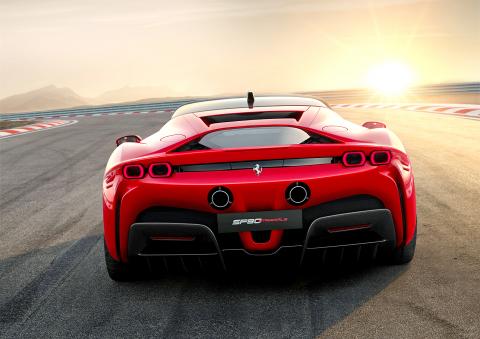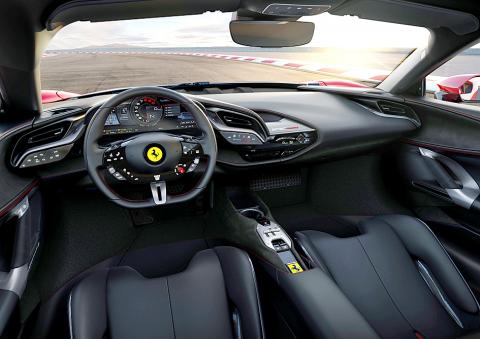Ferrari NV unveiled its first production-volume plug-in hybrid, the 1,000-horsepower SF90 Stradale, as the supercar maker aims to keep pace with tightening emissions regulations, while still satisfying its power-hungry customers.
The model is to begin shipping in the first half of next year, people familiar with the matter said.
Company chief executive officer Louis Camilleri described the new car as “astounding, fast and completely revolutionary.”

Handout courtesy of Ferrari / Reuters
It would be equipped with three electric motors, adding 220 horsepower to a 780-horsepower V8 turbo combustion engine — the highest output of any eight-cylinder engine in Ferrari history, according to a statement on Wednesday.
“It will be silent. We don’t want to hide that this car can run electric too,” company chief technology officer Michael Leiters said.
“This is the first step in a direction that Ferrari is committed to pursuing,” company chief executive officer Louis Camilleri said.

Handout courtesy of Ferrari / Reuters
By entering this segment “I am convinced that we will attract new customers who will quickly become loyal ones,” Camilleri added.
The Stradale is not the first hybrid Ferrari has ever made. In 2013, the company began selling a limited-edition supercar with the technology, the 1.2 million euro (US$1.34 million) LaFerrari, which was followed by an open-top version.
However, where only 499 examples of the first model were made, the low-slung Stradale would be part of Ferrari’s ongoing lineup.
Unlike the LaFerrari, it would be able to run in electric-only mode for at least 25km, “ideal for city center driving or any other situation in which the driver wishes to eliminate the sound of the Ferrari V8,” the statement said.
The Stradale represents the initial thrust of the Italian sports-car brand’s plan to comply with tightening rules on carbon emissions in the EU. Maranello-based Ferrari expects to equip about 60 percent of total production with a hybrid engine by 2022.
The new model is also the first Ferrari sports car to be equipped with four-wheel drive, a step necessary to fully capture the power unleashed by the hybrid powertrain. From a standing start, it would be able to reach 100kph in 2.5 seconds.
Ferrari did not disclose the price of the new car. It would fall somewhere between the 300,000 euro Ferrari 812 and the LaFerrari, company chief marketing and commercial officer Enrico Galliera said at an unveiling event on Wednesday.
While Ferrari trails much of the industry in shifting to electrified vehicles, plans have been in the works since at least 2015, when the late-chief executive officer Sergio Marchionne spun off the 72-year-old company from Fiat Chrysler Automobiles NV.
Hybrid power units where introduced into Formula One racing in 2014, helping to facilitate the transfer of technology to Ferrari road cars.
At the time, Ferrari was working on a battery-powered supercar to challenge Tesla Inc.
A fully electric supercar could come after 2022, Marchionne’s successor, Louis Camilleri, said in January.
The unveiling comes in the same week that Fiat Chrysler pitched a merger deal with French peer Renault in part to catch up in the electric vehicle market.
There is also an emerging new breed of high-performance, or premium, electric sports cars. These so-called supercars include Tesla’s upcoming Roadster Founder Series, which is to sell for more than US$200,000 and the Rimac Concept Two, priced in the region of US$2 million.
The luxury carmaker Ferrari has escaped much of the pressure that has beset auto industry, where manufacturers are struggling with declining markets and electric-vehicle investments that dent profits.
Supplying cars to the world’s wealthiest people, Ferrari trades with a valuation on par with luxury retailers like Prada SpA, and its 14 percent jump in first-quarter profit beat the highest estimate.
About 2,000 selected customers from all over the world were invited to Ferrari from Wednesday evening to Friday to view and reserve the new car, which would be delivered within 12 months.
Other buyers would have to wait more than a year for their order. Ferrari sells more than 65 percent of its cars to clients who already own one.
Camilleri said that the company aims to generate 2 billion euros in adjusted earnings before interest, tax, depreciation and amortization by no later than 2022.
To get there, Ferrari is planning more profit-boosting, limited-edition sports cars, saying last year that it planned 15 new models, including hybrids, a utility vehicle and special editions, in its drive to hit the company’s mid-term earnings target.
Additional reporting by Reuters

Three experts in the high technology industry have said that US President Donald Trump’s pledge to impose higher tariffs on Taiwanese semiconductors is part of an effort to force Taiwan Semiconductor Manufacturing Co (TSMC, 台積電) to the negotiating table. In a speech to Republicans on Jan. 27, Trump said he intends to impose tariffs on Taiwan to bring chip production to the US. “The incentive is going to be they’re not going to want to pay a 25, 50 or even a 100 percent tax,” he said. Darson Chiu (邱達生), an economics professor at Taichung-based Tunghai University and director-general of

‘LEGACY CHIPS’: Chinese companies have dramatically increased mature chip production capacity, but the West’s drive for secure supply chains offers a lifeline for Taiwan When Powerchip Technology Corp (力晶科技) entered a deal with the eastern Chinese city of Hefei in 2015 to set up a new chip foundry, it hoped the move would help provide better access to the promising Chinese market. However, nine years later, that Chinese foundry, Nexchip Semiconductor Corp (合晶集成), has become one of its biggest rivals in the legacy chip space, leveraging steep discounts after Beijing’s localization call forced Powerchip to give up the once-lucrative business making integrated circuits for Chinese flat panels. Nexchip is among Chinese foundries quickly winning market share in the crucial US$56.3 billion industry of so-called legacy

Hon Hai Precision Industry Co (鴻海精密) is reportedly making another pass at Nissan Motor Co, as the Japanese automaker's tie-up with Honda Motor Co falls apart. Nissan shares rose as much as 6 percent after Taiwan’s Central News Agency reported that Hon Hai chairman Young Liu (劉揚偉) instructed former Nissan executive Jun Seki to connect with French carmaker Renault SA, which holds about 36 percent of Nissan’s stock. Hon Hai, the Taiwanese iPhone-maker also known as Foxconn Technology Group (富士康科技集團), was exploring an investment or buyout of Nissan last year, but backed off in December after the Japanese carmaker penned a deal

WASHINGTON POLICY: Tariffs of 10 percent or more and other new costs are tipped to hit shipments of small parcels, cutting export growth by 1.3 percentage points The decision by US President Donald Trump to ban Chinese companies from using a US tariff loophole would hit tens of billions of dollars of trade and reduce China’s economic growth this year, according to new estimates by economists at Nomura Holdings Inc. According to Nomura’s estimates, last year companies such as Shein (希音) and PDD Holdings Inc’s (拼多多控股) Temu shipped US$46 billion of small parcels to the US to take advantage of the rule that allows items with a declared value under US$800 to enter the US tariff-free. Tariffs of 10 percent or more and other new costs would slash such